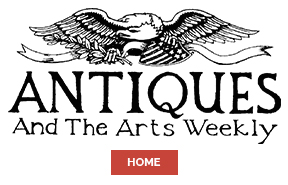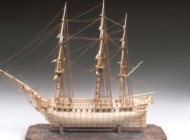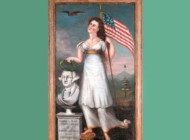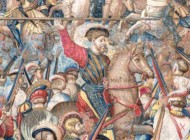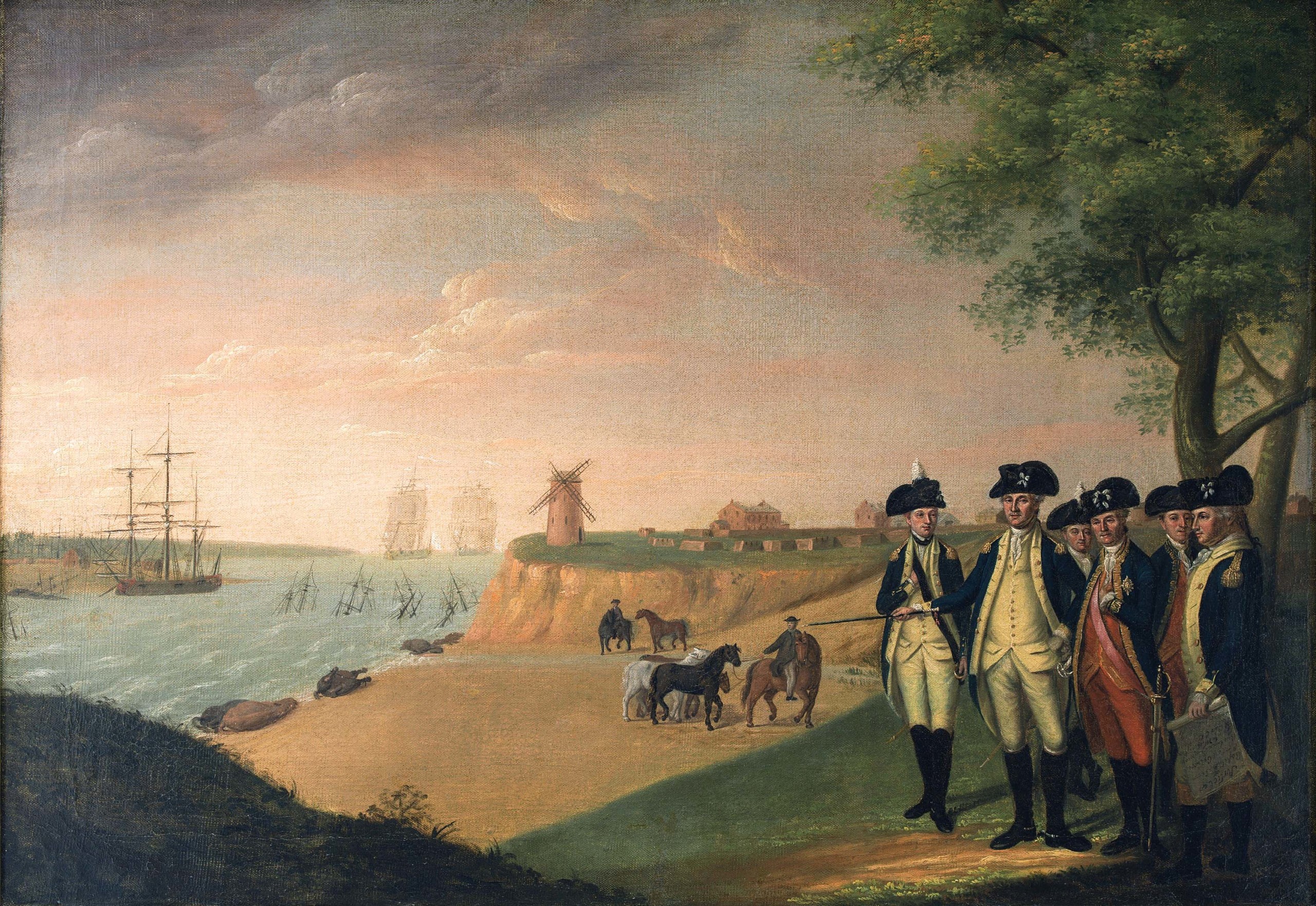
“Washington and his Generals at Yorktown,” attributed to James Peale, Pennsylvania and Virginia, 1782-1791, oil on canvas. The Colonial Williamsburg Foundation. Museum Purchase. Accession #1958-1, A&B.
By James D. Balestrieri
RICHMOND, VA. — Fittingly, “Give Me Liberty: Virginia & the Forging of a Nation,” now on view at the Virginia Museum of History & Culture (VMHC), opened on March 22, the day before the 250th anniversary of Patrick Henry’s fiery call to “Give Me Liberty or Give Me Death!” As such, the VMHC will be one of the cultural institutions that inaugurates the celebration of the 250th anniversary of the United States. Instead of retelling the story as we heard it in school, a story intended to perpetuate the mythology of our origins and inspire patriotic fervor in our breasts, “Give Me Liberty” aims to represent the American Revolution in all its complexity, as an event connected to a skein of events and ideas that included some people and excluded others — events that coalesce around the question: “Liberty, yes, but for whom?”
Ideologically, the American Revolution begins in two places, almost simultaneously — Massachusetts — specifically Boston — and Virginia — specifically Richmond and Williamsburg, the major political hubs in what was then the Colony of Virginia. The fighting, however, began in the North, at Lexington, Concord and Bunker Hill in Massachusetts. The war moved south, first through New York to the retreat after the Battle of Brooklyn. The British took and burned New York City, which would be the last place they held, though, unable to break out into the surrounding countryside, it became more of a trap than a citadel. Then, the war moved to New Jersey and Philadelphia, which the British eventually abandoned. At last, almost as if it were meant to be, the war ended, or all but, in Virginia, at Yorktown, a short ride from Williamsburg and not all that far, even then, from Richmond.
In light of the aims of the exhibition, and in view of the fact that Henry’s speech is central to the hagiography of the founding of the United States, the text of the speech itself demands a careful look. Henry begins by acknowledging those who advocated giving the mother country yet another chance, then goes on to list the reasons why this is impossible: many appeals had been made and ignored; the time might never be right to rebel; divinity would surely favor the righteous; the British were preparing for war with the Colonies. Most importantly, war had begun on “the plains of Boston.” Henry ends with the famous war cry: “Is life so dear, or peace so sweet, as to be purchased at the price of chains and slavery? Forbid it, Almighty God! I know not what course others may take; but as for me, give me liberty or give me death!”
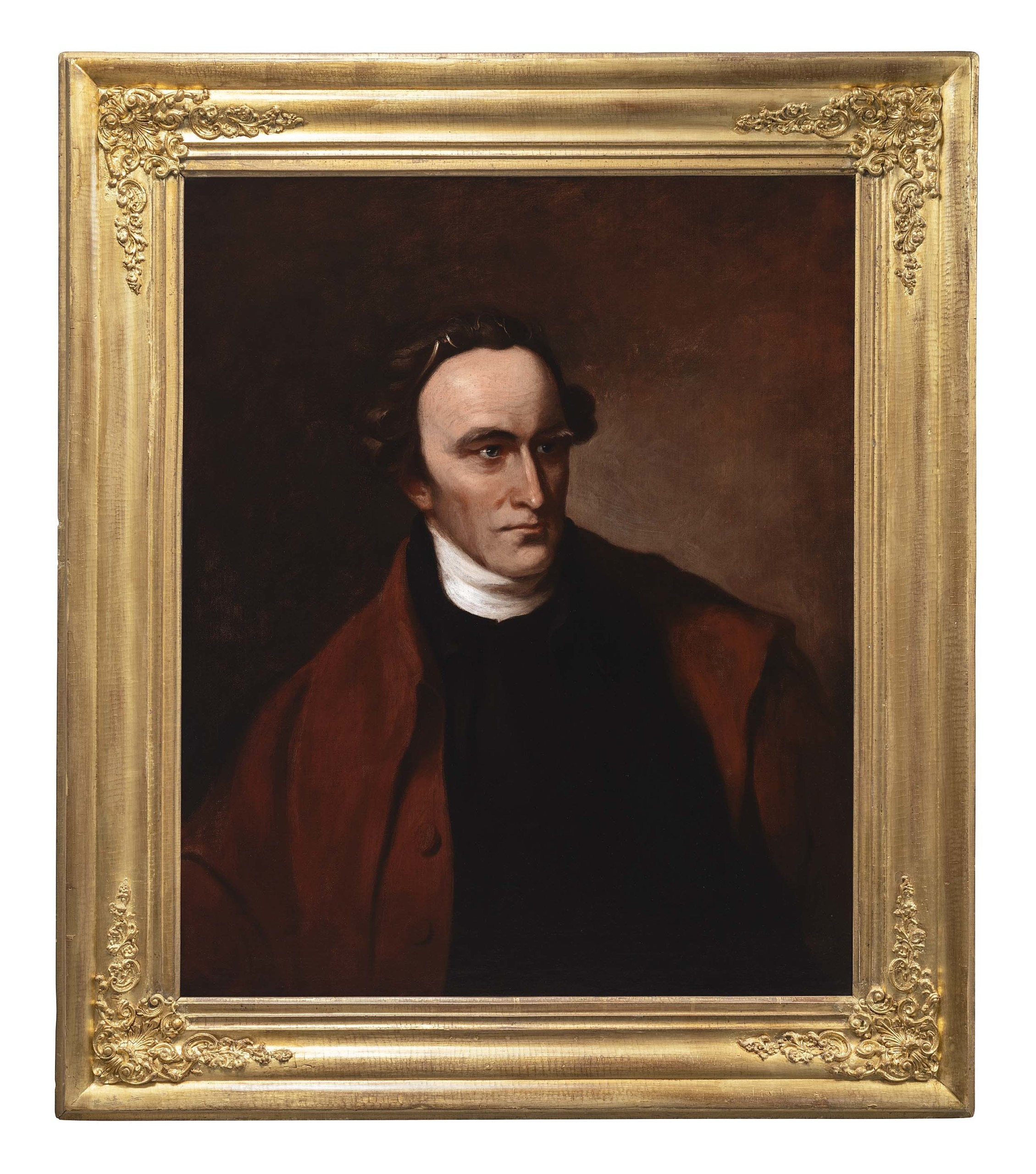
Portrait of Patrick Henry by Thomas Sully, 1851, 38¾ by 33½ inches. Gift of Thomas Sully. Courtesy of the Virginia Museum of History & Culture.
Henry’s speech, admittedly a reconstruction, repeats the word “slavery” and refers to chains over and again — as do many other founding speeches, essays and documents. From a psychological standpoint, the patriots would seem to be projecting the conditions of servitude and bondage to which they subjected enslaved Africans onto themselves, under an imagined enslavement by their paternal king and country.
Charles Willson Peale’s 1772 “Portrait of George Washington” is a good place to begin to examine the other objects in the exhibition. From 1755 to 1758, Washington commanded the Virginia Regiment during the French and Indian War. Displayed beside the painting is Washington’s silver-hilted small sword as well as a letter written by Washington from that period. The portrait reminds us that had Washington, who was in command, prevented one of his Native allies from killing a captured French officer after a battle at Fort Duquesne (the site of Pittsburgh) in May 1754 there might not have been a French and Indian War at all. And it’s the French and Indian War that leads directly to the American Revolution, so we might say that while Washington won the American Revolution, he also started it — inadvertently.
Even as it questions many of the lessons we learned in school and the truths we consequently take for granted, the exhibition also illuminates our beginnings, taking care to include the voices of those excluded from Henry’s notion of “liberty”: Enslaved Africans, Indigenous peoples, women and all those who did not own property. Sidelined as they may have been from the fruits of the revolution, their participation was anything but ancillary and their position vis-a-vis the two sides might best be described as equivocal. The British and their allies in America, for example, actively recruited Black individuals, guaranteeing freedom for the enslaved who joined in the Tory cause and castigating the patriots’ rhetoric of “liberty” as hypocritical since it saw slavery as an institution that could and would not be touched by revolution. One of the most fascinating documents in the exhibition that underscores this is the Broadside of Dunmore’s Proclamation, Nov. 7, 1775, probably printed by Alexander Cameron and Donald McDonald aboard the HMS Otter. Lord Dunmore’s Proclamation contains the following astonishing sentence, one that comes with its own caveats: “And I do hereby further declare all indentured Servants, Negroes or others, (appertaining to Rebels,) free that are able and willing to bear Arms, they joining His MAJESTY’S Troops as soon as may be, for the more speedily / reducing this Colony to a proper Sense of their Duty, to His MAJESTY’S / Crown and Dignity.” It’s the bit in parentheses, “(appertaining to Rebels),” that ought to give you pause. Dunmore declares that slaves belonging to Rebels should, effectively, run away and join the British army and, should they survive the war, they will be free. Pro-Crown citizens may, and should, keep their slaves at home.
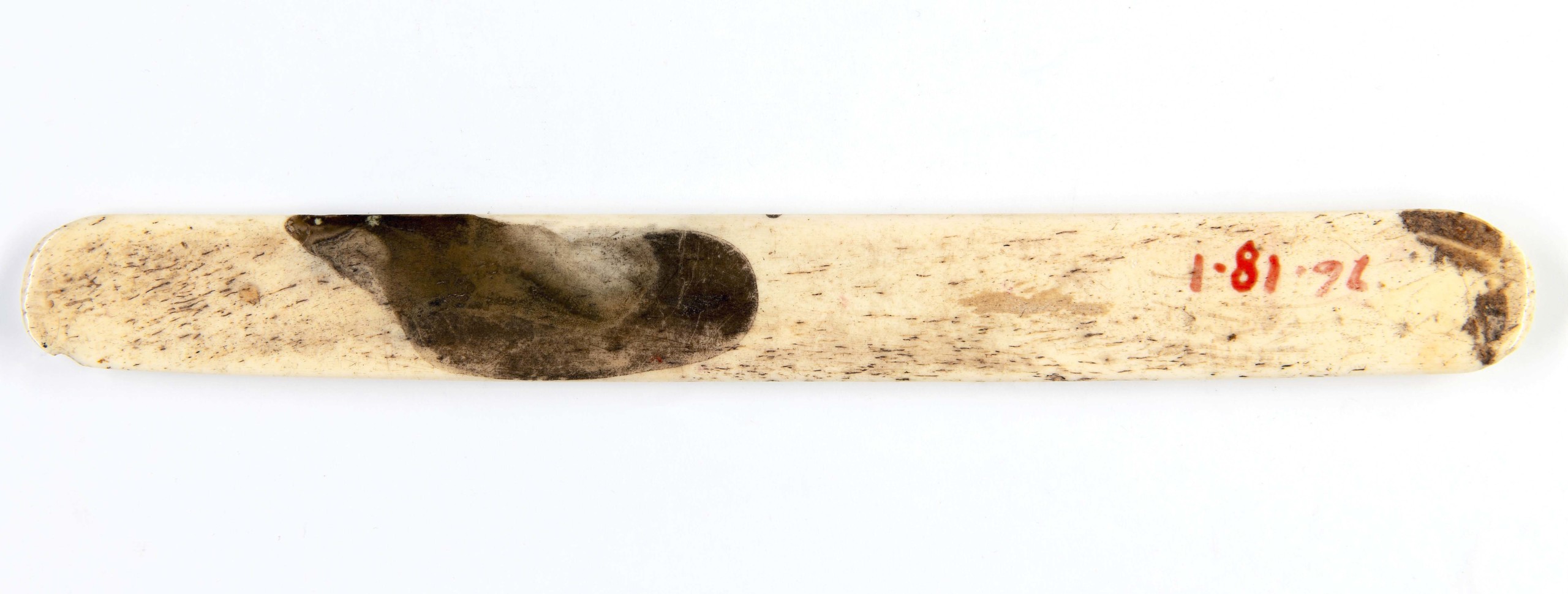
Whalebone paper cutter associated with Patrick Henry’s “Give Me Liberty” speech, Eighteenth Century. On loan from Patrick Henry’s Red Hill.
As for the other groups that were left out of the cry for “Liberty!,” all but a few Native American Peoples fought on the British side, having seen and felt the full force of the colonial program. Of the Six Nations Confederacy, only the Oneida and Tuscarora fought on the American side and, it must be said, they received little for their sacrifice. The catalog notes, “With a blade on one side and a pipe bowl on the other, [Pipe Tomahawks, like the one in the exhibition] were traded between Indigenous peoples and Europeans. [They represent] a complex relationship between the two communities, which included both war and peace.” Women served, following their husbands to war, fighting laboring in every capacity, from suppliers to scribes to spies — Betsy Ross was, as history has revealed, pretty much the Mata Hari of the Revolution. Lastly, white men without property did most of the fighting and dying in the revolution, though white male suffrage did not generally include the “propertyless” until 1828, long after most of the veterans of the American Revolution had passed away.
Beginnings, endings, new beginnings, nascent ideals and enduring injustices, lofty rhetoric and expedient pragmatism. The tensions ooze from the objects in the exhibition because of their deft curatorial placement. The Yorkshire teapot from 1780 represents British America — its ambitions and its attempts to impose its refinements on the Colonies, while the “I Love Liberty” teaspoon, fashioned in London in 1773 for the American market, reflects both the ambivalence of many in England about American independence as well as the economic interdependence between motherland and colonies.
There’s a humble object in the exhibition, however, one that viewers might easily overlook, that tells what might be termed a telling tale: the wax impression of the Colonial seal of Virginia, which was issued during the reign of King George I (r 1714-1727). As the exhibition text sums up nicely: “This wax seal depicts a kneeling Virginia Indian gifting tobacco to King George I. Indigenous peoples introduced tobacco to English colonists, and its cultivation became colonial Virginia’s most important industry. Tobacco’s expansion led to the taking of Virginia Indian lands and the importation of enslaved Africans as a workforce.” A seal is an emblem in that it is an image that is symbolic of places and relationships. Emblems were prevalent in the Seventeenth and Eighteenth Centuries; they were ways to express power over the natural world and over other people. The emblems of the era give rise to the Great Seal of the United States and the seals that “emblematize” the individual states and territories. In the Colonial Seal of Virginia, we have to remember that the “Virginia Indian” kneeling is an emblem of the Colony of Virginia as a whole. He represents not only Indigenous Peoples but enslaved Africans and the colonists themselves. The English saw the colonies as backwards and colonists as uncouth — not dissimilar, in fact, from Natives — and subservient to the Crown, though in an imagined paternal relationship rather than a master/slave dichotomy. Thus, in the seal, Virginia kneels before the King, offering tobacco as a gift, as tribute, rather than a commodity. The iconography is clear and foreshadows the ultimate desire of all colonies to unfetter themselves from the condescensions of overseas rule.
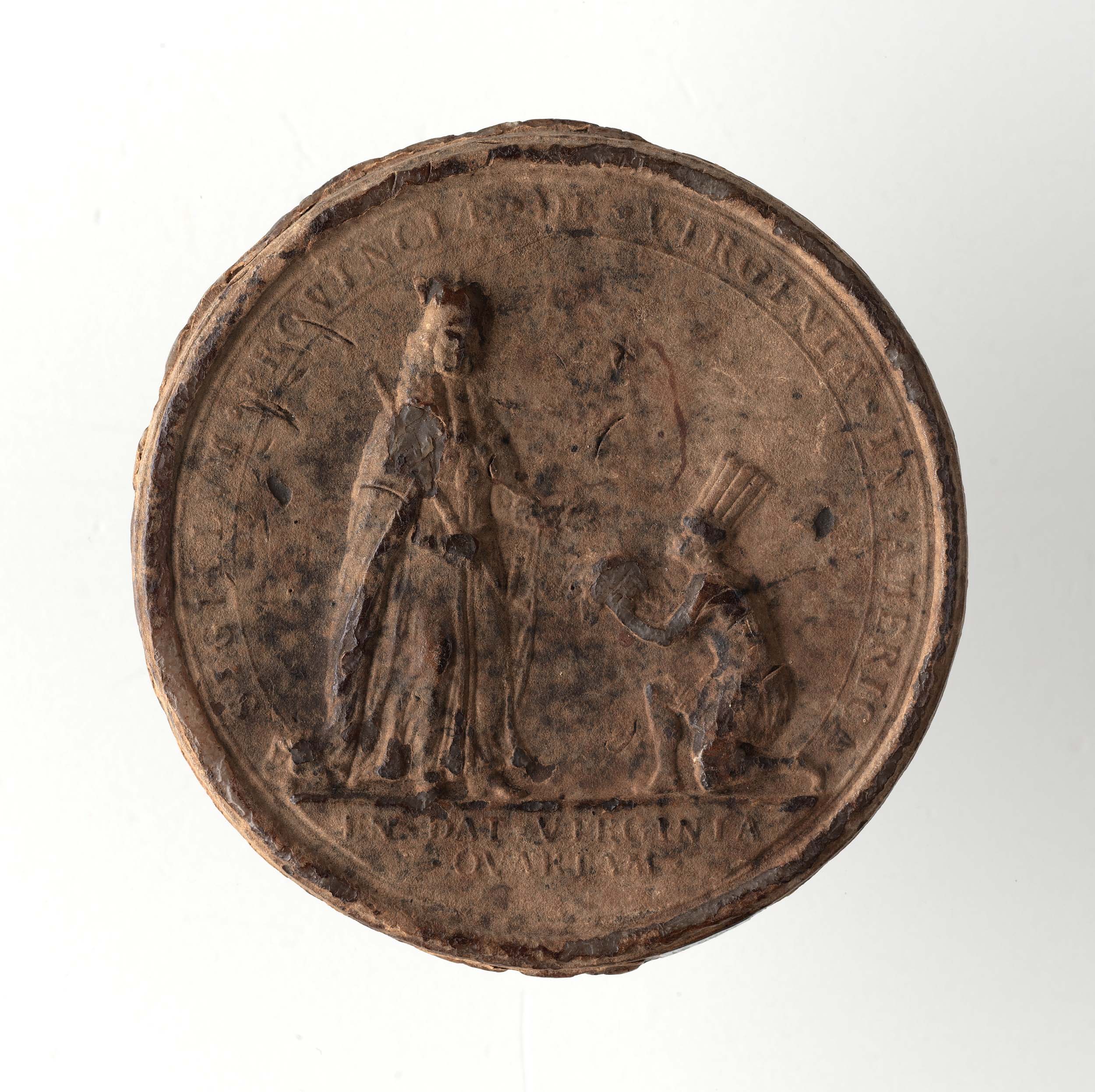
Wax impression of the Colonial Seal of Virginia, issued during the reign of King George I (r 1714-1727), 4¼-inch diameter. Gift of R.F. Taylor. Courtesy of the Virginia Museum of History & Culture.
Despite the fascinating complexities in the American origin story, the pealing of the bell from St John’s Church in Richmond, which would have rung after Patrick Henry’s speech, marks an inflection point. If Patrick Henry could end his oration on the thunderous “Give me liberty or give me death!,” what would prevent others, even and perhaps especially those among the excluded, from repeating his words as their own rallying cry? Freedom and equality start somewhere, perhaps nowhere better than a place where their denial is part of everyday life, and Virginia is one of the places where the very human drive for freedom and equality began.
“Give Me Liberty: Virginia & the Forging of a Nation” is on view until January 4.
The Virginia Museum of History & Culture is at 428 North Arthur Ashe Boulevard. For information, 804-340-1800 or www.virginiahistory.org.
